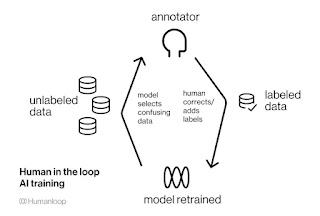Leaders are scrambling today to somehow integrate AI into their organizations. Many companies and institutions who are at the forefront of this have written some whitepapers, and I have picked 3 AI Usage Frameworks that I liked for developing your own Organizational AI Adoption Plan. A good plan, like any, should bring cross-functional leadership to the table and discuss a model and a plan before driving the implementers or engineers to adopt it because everybody else is doing it.
---------------------
Microsoft’s AI Maturity Model proposes the stages of AI adoption in organizations and how human involvement changes at each stage: |
| Source: https://devblogs.microsoft.com/azuregov/fed-agencies-exec-order-ai-part1/ |
- Provide a framework for Federal agencies to shift from Cultural Shift to Ownership, recognizing governance, innovation, risks, and compliance as key pillars.
- Assisted Intelligence: AI provides insights, but humans make decisions.
- Augmented Intelligence: AI enhances human decision-making and creativity.Mic
- Autonomous Intelligence: AI makes decisions without human involvement.
HBR's Human-AI Teaming Model outlines a framework for this type of collaboration. It emphasizes that AI should augment human work rather than replace it.
- AI as a Tool: AI supports human decision-making by providing data-driven insights.
- AI as a Collaborator: AI assists humans by sharing tasks and improving productivity.
- AI as a Manager: AI takes over specific management functions, such as scheduling or performance monitoring.
The “Human-in-the-Loop” AI Model (MIT) ensures that humans remain integral to AI processes, particularly for tasks requiring judgment, ethics, and creativity.
 |
| Source: Human in the Loop AI Training |
- Active learning is a form of human-in-the-loop training in which the model selects the data to be annotated. This helps in rapid model iteration and reduces by 10x annotation requirements, making these models augmentative ready and efficient. AI Automation:
- Tasks AI can handle entirely.
- Human-in-the-Loop: Tasks where humans make critical decisions or review AI outputs.
- Human Override: Tasks where humans can override AI outputs in sensitive areas.
PwC’s AI Augmentation Spectrum highlights six stages of human-AI collaboration:
 |
| Source: Human-AI Augumentation Model (pwc) PWC believes that content generation will fall into a couple of scenarios: human-created, AI-created, AI-created and validated, and AI-created augmented. And this will evolve a process that builds an exciting and creative AI-augmented human society with a broad spectrum of co-creation. AI as an Advisor: Providing insights and recommendations. |
- AI as an Assistant: Helping humans perform tasks more efficiently.
- AI as a Co-Creator: Working collaboratively on tasks.
- AI as an Executor: Performing tasks with minimal human input.
- AI as a Decision-Maker: Making decisions independently.
- AI as a Self-Learner: Learning from tasks to improve over time.





No comments:
Post a Comment
Note: Only a member of this blog may post a comment.